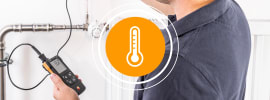Testo Tech sheets:
The testo 890 thermal imager for Research and Development

Ambient radiation 95 %
Object radiation 5 %
testo 890: see more thanks to excellent temperature measuring accuracy.
The testo 890 thermal imager has one of the best temperature measuring accuracies in their instrument class. This means they are ideally suited for tasks in research and development which require the utmost precision.
Testo guarantees a measuring accuracy of ±2°C or ±2% for the testo 890 thermal imager. These values do not just apply to one or two individual reference points, but to the whole thermal image and every individual measuring value. Furthermore, the temperature measuring accuracy is also guaranteed over the entire ambient/operating temperature from -15°C to +50°C. Why is that the case?
Detector
The sensor is the heart of every thermal imager. It comprises a matrix with very small infrared-sensitive pixels which convert the incident electromagnetic radiation of the measurement object into an electronic signal. The entirety of the pixel signals create a digital image. The digital image shows the surface temperature of the object and depicts this as a false colour image in the camera. The process involves every individual pixel getting a temperature value by scaling and the selected palette a defined colour in the false colour image. The speed of a thermal imager depends on the time required to create an individual image. The testo 890 thermal imager has an image refresh rate of up to 33 Hz.
The detector of a Testo thermal imager can measure electromagnetic radiation in an atmospheric window between 7.5 and 14 µm. The ambient temperature (300 K) has the highest radiation intensity at a wavelength of 9.89 µm (Planck's radiation spectrum). A Testo thermal imager's detector is therefore designed to have the highest sensitivity at the 9.89 µm wavelength.
Log in now and find out more!
Would you like to find out more about the performance of thermal imagers from Testo? Then request the other 3 tech sheets straight away too.
It only takes a minute to log in and you will get comprehensive information about the following technologies:
Design and sensitivity of the infrared detector
Detailed analysis options due to minimum focusing distance
Improvement of resolution through the testo SuperResolution Technology
Fast and precise analysis via the LabVIEW™ interface







































